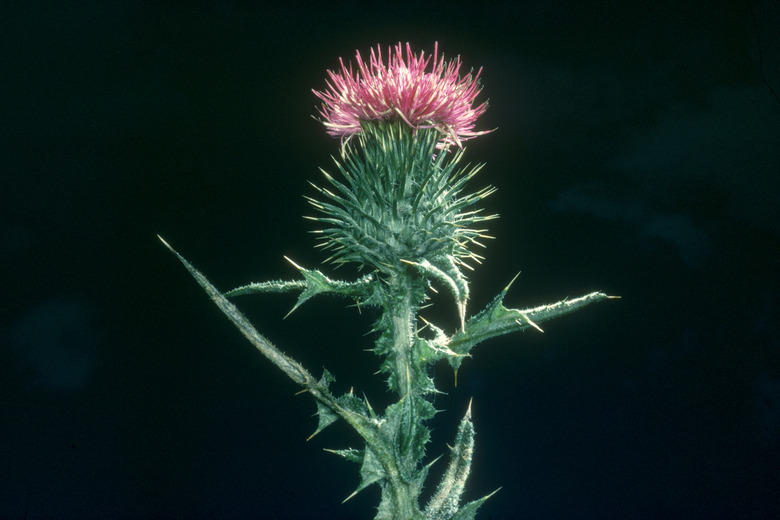Thistle Identification
Years ago, thistle was a revered plant. Nowadays, many consider it an annoying weed. With its vivid purple flowers and thorny leaves and stems, thistle can quickly take over a garden or landscape. Though the different thistles share similar characteristics, there are ways to identify each individual type.
Bull Thistle
Prevalent in the United States and Canada, bull thistle (Cirsium vulgare) is invasive and difficult to manage. Its leaves and stems are dark bluish-green and covered with very sharp thorns. Bull thistles are biennial and only bloom in the second year. Pull thistles before they bloom so their seeds don't spread in the wind.
Bull thistle thrives in sunny areas in a variety of soil types and conditions. Though bull thistle is difficult to contain, frequent mowing before it flowers can help keep it under control. A chemical vegetation killer can help eliminate bull thistle if mowing and pulling don't work.
Canadian Thistle
Canada thistle (Cirsium arvense, zones 4-7) is also difficult to control and can quickly infect gardens and fields. If left to grow, this type of thistle can reach 3 to 4 feet tall and will have soft, green, spear-shaped leaves that are covered with barbs. Canada thistle grows a round purple flower that quickly turns into a white dandelion-like seed. Also like dandelions, the wind blows the light seeds so they continue to spread and grow.
Because of its deep, wide-spreading roots, Canadian thistle is difficult to control. Use a chemical weed killer if pulling or mowing doesn't work to control the problem.
Milk Thistle
Common to Europe and Asia, but also found in the United States, milk thistle (Silybum marianum, zones 5-10) grows quickly and is oblivious to frost. Milk thistle is partial to rocky soil and can grow up to 4 feet tall. Identify milk thistle by leaves with white veins and hairy seeds on its pink flowers. Milk thistle seeds are medicinal and often used in tea to help with liver and kidney ailments.
Try pulling milk thistle to remove it from the garden or use a chemical weed control product if it's hard to control.
Russian Thistle
Annual Russian thistle (Salsola tragus) is often found in the American West. An invasive, bushy plant, it grows up to 36 inches tall and is known for its heavy seed production. Because the flowers on Russian thistle are green, they're not obvious from afar. Up close, it's easy to distinguish leaves and flowers.
As Russian thistle propagates and bears seeds, the bush dries and breaks loose of the desert soil. As fans of Western books and movies know, once the Russian thistle breaks free from the ground, it becomes what's known as a tumbleweed. As the tumbleweed rolls around, the seeds spread and the growing cycle begins again.
Planting crops can help control Russian thistle as the new plants make it difficult for the seeds to find a place to take root. Mowing and pulling young plants can also help to keep it under control. If the Russian thistle gets too invasive, using a chemical solution can help to control, if not eliminate, the problem.
Scotch Thistle
Native to Europe and the Mediterranean, but also common in the United States, Scotch thistle (Cynara cardunculus, zones 7-10) is a slow-growing biennial. Identify Scotch thistle by its rich purple blooms and the thick, spiky hairs on its leaves. Scotch thistle was once an ornamental plant, rich with symbolism, but is now considered an invasive weed.
With its long roots, Scotch thistle is hard to remove completely. Use a chemical weed solution if this thistle isn't easy to manually control.
